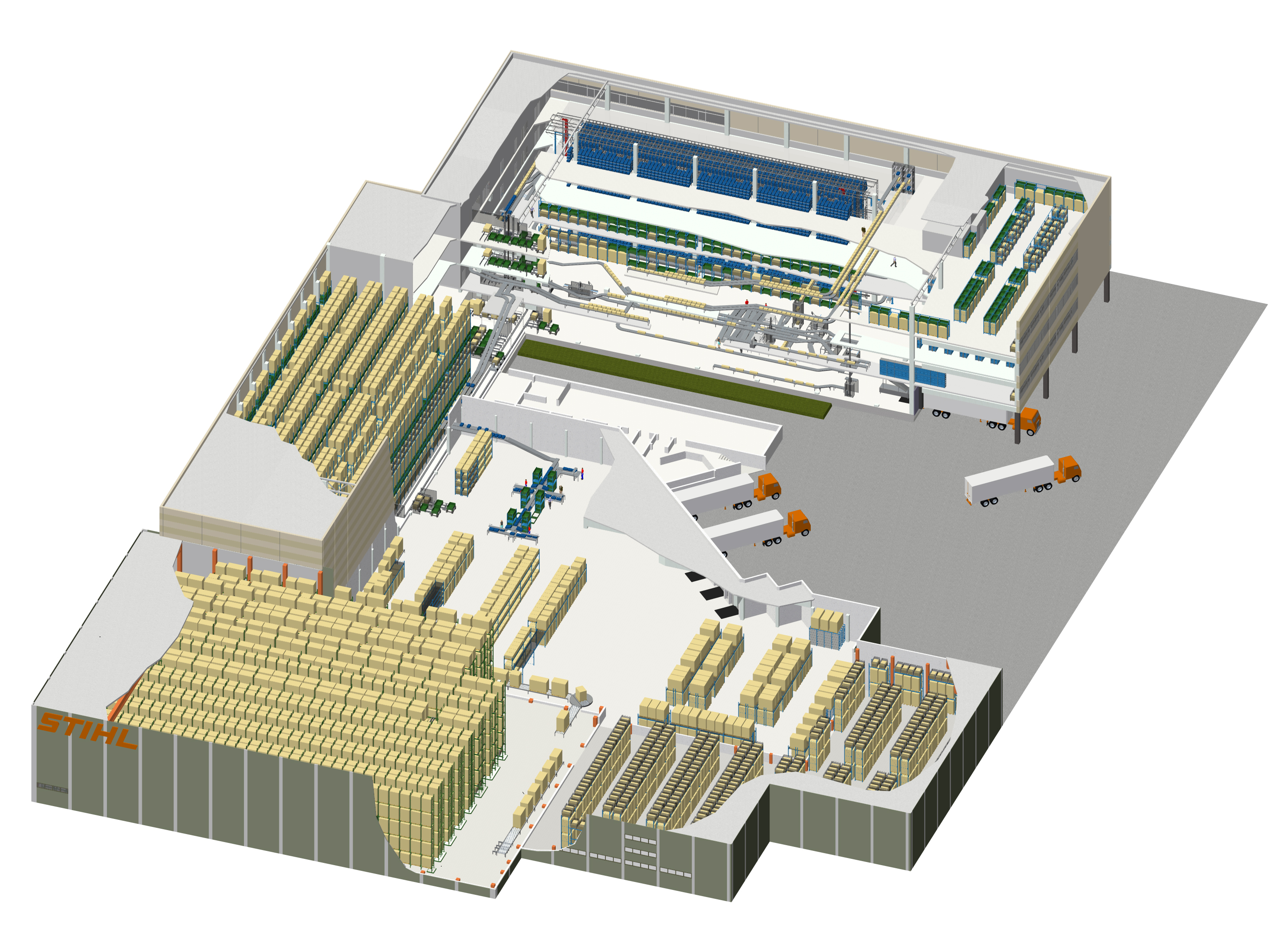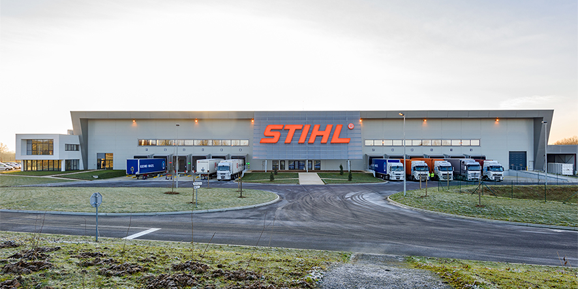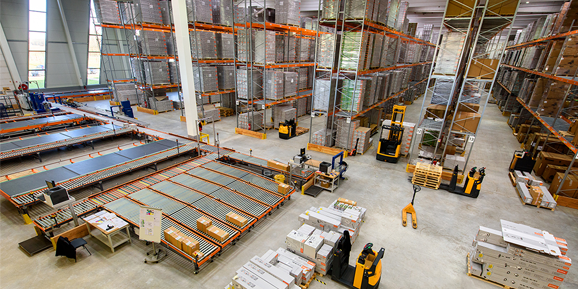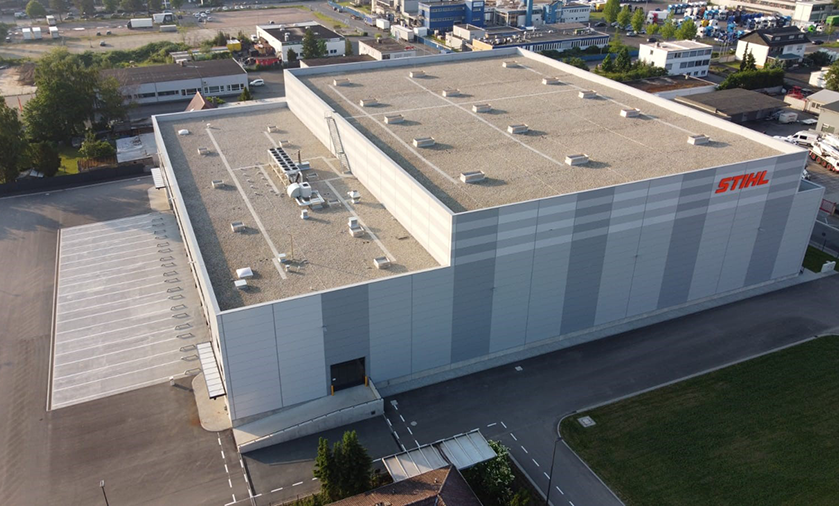Stihl develops, manufactures and sells power tools for forestry and agriculture as well as for landscape maintenance, the construction industry and private users. The product range is complemented by digital solutions and services. The products are generally sold via service-providing specialist dealers – with 41 own sales and marketing companies, around 120 importers and more than 54,000 specialist dealers in over 160 countries. Stihl employs around 18,200 people worldwide, 300 of whom work at the sales centre in Dieburg in southern Hesse.
Dieburg: Redesign of the distribution centre in Germany

The new Stihl Dieburg distribution centre
The challenge
The Stihl distribution centre had been recording steady sales and volume growth for years. It was foreseeable that the existing processing and storage areas as well as the order picking areas would reach their limits in the long term. The logistics area had to be expanded in order to meet the company’s own service and quality standards and to fulfil future requirements.
The task
Stihl commissioned viaLog Logistik to develop and realise a long-term logistics concept for the Dieburg site. This concept was to be realisable in several stages and also enable future expansions. A particular focus was placed on increasing processing productivity and flexible storage.
The solution
The long-term concept developed by viaLog enables a significant increase in storage capacity. It divides the logistics centre into two areas – one for finished goods and one for spare parts and accessories. Both areas use a shared building for incoming goods, but have their own storage areas, picking and loading zones. This separation takes into account the different processing and storage of the product ranges. The productivity of both areas has been sustainably improved in this way.
On-site measures
In the first stage, the existing building complex was extended to include a new high-bay warehouse for spare parts and accessories. In addition, a four-storey order picking building with an adjoining loading zone was created. In the second step, additional conveyor technology was implemented in the order picking building for spare parts and accessories, which enables partially automated order picking. The capacities of the order picking building were gradually expanded on all floors.
Technology and IT deployment
- 2-aisle automatic small parts warehouse
- Container and parcel conveyor technology
- Pallet conveyor technology
- Specialised WMS
- Pick-by-light system
- Carton erectors and lidding machines
- Various automatic labelling machines
The highlights
Partial manual processing
Although the distribution centre has a high throughput, only part of the logistics processing has been automated. The A assortment is handled in a zone picking system with a pick-by-light area, while the B and C assortments are processed manually.
Passing on in multi-storey buildings
In the four-storey order picking building, numerous incoming and outgoing processes are interlinked. Many new subsystems have also been implemented. To ensure that each order can be routed through the building with maximum efficiency, a balanced distribution of the product ranges is a basic prerequisite. This was ensured by a separate simulation of the processes in each individual expansion phase.

Interior view of the distribution centre
France: Expansion of distribution logistics

Stihl Torcy distribution centre, France
The challenge
Stihl’s sales office in France distributes the products independently throughout the country. Steady sales and volume growth was planned for the distribution centre in Torcy near Paris. The existing central warehouse was no longer able to meet the increasing demands on service and quality in the short to medium term.
The task
viaLog Logistik Beratung GmbH had already successfully implemented an expansion and optimisation project for Stihl’s German distribution centre in Dieburg. The East Westphalian consulting company has now been commissioned to realise a similar project in France. This included the detailed planning of the warehouse expansion, the invitation to tender for the logistics IT and logistics technology as well as support during realisation.
The solution
The concept drawn up by viaLog envisaged a combination of automated areas and manual processing as well as the introduction of new warehouse management software (WMS). An automated container warehouse with shuttle technology was chosen for three reasons:
- Storage in small load carriers and plastic containers is the most sensible storage method for the majority of the spare parts and accessories range.
- The container storage system is space-saving and offers optimum storage density.
- Automation enables high employee productivity.
Each level of the three-aisle warehouse, which has 26,000 storage locations, is served by a shuttle. The containers can be divided into up to four compartments to optimise the use of the storage volume. Storage in the new shuttle warehouse takes place at stationary workstations. Empty containers are automatically fed in and used for receiving and posting with the new WMS. Picking is carried out at four ergonomically designed workstations, among other things. Here, empty target cartons and source containers are automatically provided, picked and removed again in the required processing sequence.

Finished goods sorter
Highlights
Container storage with shuttle technology
A space-saving and labour-saving container warehouse was built according to the goods-to-man principle. In comparison, this achieves the highest productivity with a positive amortisation period.
Ergonomic workstations
Pick-by-light picking is back-friendly and takes place in an optimised gripping position.
International project management
In France, cooperation with a logistics consultant is rather unusual. Stihl was therefore all the more satisfied with the excellent cooperation between the French team and the consultants from viaLog. It was possible to jointly develop and implement cross-departmentally accepted solutions according to the viaLog standard.
Dieburg: New warehouse for finished goods, optimisation of inventory logistics

Dieburg logistics centre. Images: Stihl
The challenge
Stihl and viaLog can look back on several successful expansion and optimisation projects at the Dieburg site, which were implemented as part of a long-term master plan. Traditionally, the logistics centre is divided into two areas – one for finished goods and one for spare parts and accessories. Previously, both areas used a shared building for incoming goods, but had their own storage and processing areas for picking and loading.
Stihl was aiming for further sales and volume growth, combined with an expansion of the product range and the development of new sales channels and additional services. Against this background, it was foreseeable that the existing structures at the Dieburg site would reach their limits. It became necessary to secure the future viability of the logistics centre.
The task
Stihl commissioned viaLog to design a new building for the finished goods handling department. In addition to the building concept, the project included the detailed planning of the warehouse and equipment technology, the tendering process, project realisation support and support during the test and acceptance phase.
In addition, the existing logistics structures and workplaces should be examined for possible optimisation potential – particularly with regard to automation and ergonomics at the workplace.
The solution
At the heart of the new finished goods building are a four-aisle narrow-aisle warehouse (SGL) and a wide-aisle warehouse (BGL) with a total of 4,900 pallet spaces on a total area of 7,200 square metres. The lower level of the BGL is intended for order picking, while reserve stocks are stored on the second level – as in the SGL. Expansion of both the SGL and the BGL is flexibly possible.
The entire finished goods warehouse is accessed by pallet conveyor technology from the loading station at goods-in. For the management of SGL and BGL, Stihl uses narrow-aisle and reach trucks, pedestrian trucks and order picking vehicles.
Higher productivity in the spare parts warehouse
The construction of the new finished goods warehouse has freed up storage space in the spare parts area for future growth. It was also possible to further increase the productivity of spare parts logistics through tuning. To relieve the manual picking areas, around 6,000 slow-moving items have been moved to the existing small parts warehouse and will be processed according to the goods-to-man principle in future. Stihl has set up an additional picking workstation for this purpose and connected it via conveyor technology. Two walking beam devices enable the buffering of shipping cartons and source containers. Both the feeding of the source containers and the delivery of the target cartons are fully automated. After picking, the source containers are returned directly to the miniload.
Four new packing stations are planned for the B2C area, which have been connected to the existing conveyor technology with new feed conveyors. Packing materials and printers are provided in the immediate vicinity of the employees.
The highlights
Optimised use of conveyor technology: Storage and retrieval in the finished goods warehouse is supported by the intelligent use of pallet conveyor technology. This also serves as a buffer section to relieve the incoming goods areas. In the narrow-aisle warehouse, induction-guided forklift trucks are used not only to manage the warehouse, but also to approach the loading and removal station.
Focus on ergonomics: Stihl sets the highest standards for workstation ergonomics. The planners at viaLog took this requirement into account with a series of measures:
-
-
- Order picking vehicles with special suction pads are used for bulky and heavy items.
- Back-of-hand scanners ensure faster, more flexible and more ergonomic picking, as the employee has both hands free to reach. Important information is displayed directly on the scanner, saving walking distances. Processing is faster and less error-prone overall.
- Height-adjustable lifting tables and scales enable a back-friendly packing process. Packing materials and printers are provided in the immediate vicinity of the employees.
-
Future-orientated solution: The expansions will take place in stages as part of a long-term logistics masterplan for the site. Further capacity expansions are already planned in the concept and some are already being realised.


